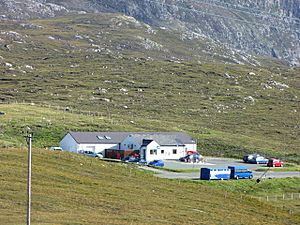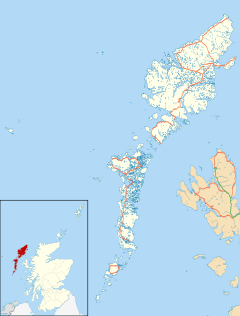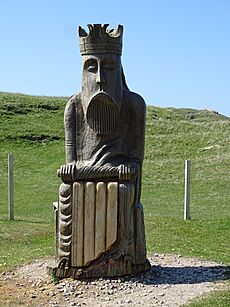Uig, Lewis facts for kids
Quick facts for kids Uig
|
|
|---|---|
 Uig Community Shop |
|
| Demonym | Ùigeach |
| Language | Scottish Gaelic English |
| OS grid reference | NB022334 |
| Civil parish |
|
| Council area | |
| Lieutenancy area | |
| Country | Scotland |
| Sovereign state | United Kingdom |
| Post town | ISLE OF LEWIS |
| Postcode district | HS2 |
| Dialling code | 01851 |
| Police | Northern |
| Fire | Highlands and Islands |
| Ambulance | Scottish |
| EU Parliament | Scotland |
| UK Parliament |
|
| Scottish Parliament |
|
Uig (Scottish Gaelic: Ùig), also known as Sgìr' Ùig, is a special area in the west of the Isle of Lewis in the Outer Hebrides, Scotland. It's like a big district or community. Uig is one of four main areas on the Isle of Lewis. It includes places like Carloway, East Uig, Bernera, and West Uig. The name Uig comes from an old Norse word, Vik, which means 'a bay'.
Contents
Exploring Uig's Geography
The Uig area is quite large, covering about 250 square miles (650 km²). It stretches from the Harris border in the south to Dalmore in the north. It also goes from Brenish in the west to Lochganvich in the east. The part of Uig known locally as "West Uig" is west of Little Loch Roag. West Uig has 20 small villages, while the whole Uig parish has 36.
In the 1840s, West Uig had about 2,000 people. However, many people were forced to leave their homes during the Highland Clearances. Villages like Capadale and Erista were cleared to make space for sheep farms and hunting areas.
Bhaltos (Valtos) is the biggest village in Uig, with about 35 people. Since 1999, the land on the Bhaltos peninsula has been owned by the community. It is managed by the Bhaltos Community Trust. This area also includes the villages of Cliobh (Cliff), Cnìp (Kneep), Riof (Reef), and Na h-Ùigean (Uigen).
Uig, or West Uig, is the largest but most spread-out area on the Isle of Lewis. It has the highest point on Lewis, Mealasbhal, which is 574 meters (1,883 feet) tall. Nearby, Loch Suaineabhat is the deepest freshwater loch on Lewis. It is 61 meters (200 feet) deep. Loch Langavat is also very long, stretching over 11 km (7 miles).
The coast has many interesting inlets, like Little Loch Roag and Camas Uig.
Discovering Camas Ùig (Uig Beach)
Uig Beach (Scottish Gaelic: Camas Ùig) is famous because the Lewis Chessmen (Scottish Gaelic: Tàileasg Ùig) were found here. Before 1831, a local farmer found these old chess pieces buried in the sand after a storm. The chessmen are now in the Museum of Scotland in Edinburgh. Some are also in the British Museum in London. You can see copies at the Uig Heritage Centre in Tuimisgearraidh.
Most of the chessmen are carved from walrus tusks. They probably came from Norway around the 12th century. No one knows exactly how or when they ended up in Uig.
Camas Ùig is surrounded by the villages of Cradhlasta (Crowlista), Tuimisgearraidh (Timsgarry), Eadar Dhà Fhadhail (Ardroil), and Càrnais (Carnish). The beach is a great place for kite-buggying. It's large, flat, and often has good winds.
A Look into Uig's History
Many clues show that people from Norway, called Norse, settled here a long time ago. We know this from the names of places and from old items found by archaeologists. Some of these items are on display at the Uig Museum. The name Uig itself comes from the Old Norse word ‘Vík’.
During the Napoleonic Wars, many soldiers were recruited from Uig to join the 78th Seaforth Highlanders. They fought in battles like Maida in Italy in 1806 and Java in 1811. Even though many men served, the area still faced widespread evictions in the 1800s. This was to create larger sheep farms and hunting estates.
Villages around Uig Bay that were cleared included Capadale and Mealastadh. Around the 1840s, the system of crofting began. This created the small land holdings and village patterns we see today. Crofting alone often wasn't enough to support families. So, other jobs like the kelp industry (using seaweed) and fishing were very important.
Uig's Population Over Time
Today, about 400 people live in Uig. This is the lowest number ever recorded. The population is also getting older. In 1841, before the evictions, there were 1,923 residents. Many people were forced to leave on ships like the "Marquis of Stafford" in 1851. By the early 1900s, there were 1,631 residents. After World War II, the population dropped below 1,000.
According to the 2011 census, 56% of people in Uig parish speak Scottish Gaelic.
The Clan MacAulay Connection
Uig is the historic home of the Clan MacAulay (Mac Amhlaigh). DNA tests show that this family originally came from Ireland. They are different from other Macaulay families on Lewis who have Nordic roots. A famous chief of the Uig Macaulays was Donald Cam MacAulay. His family includes Zachary Macaulay, who fought against slavery, and his son Thomas Babington Macaulay, 1st Baron Macaulay, a famous historian.
It is also believed that Coinneach Odhar, the Brahan Seer, was born in Uig. He was a prophet from the 16th century, similar to Nostradamus.
Ancient Sites and Discoveries
One of the most important ancient sites in Uig is the Callanish Stones. These are very old stone circles from the Neolithic period. They are shaped like a cross, with a path leading to the center. This main site is connected to seven other stone circles nearby.
Dun Carloway is a well-preserved Iron Age broch (a type of ancient round tower) in Scotland. Other brochs in the area include Dùn Borrainis and Dùn Bharabhat.
At Cnìp, archaeologists found a well-preserved wheelhouse (an ancient house) and two brochs. In 1979, a rich Viking burial of a woman was discovered on Cnìp headland. More recently, in 2009 and 2010, three other burials were found. These contained the remains of nine people from between 1770 and 1620 BC.
The Lewis Chessmen were found at Pennydonald, near Camas Uig, in 1831.
You can also see the remains of old circular houses at Bòstadh, Bernera. These date back to the Iron Age. A rebuilt version of one of these houses is nearby. Other ancient houses with overlapping stone roofs, called "beehive dwellings," are found on the Morsgail Moor.
Throughout Uig, you can find the remains of many old Norse water mills. These mills used flat, carved millstones. Only one, at Breaclet, Bernera, still has its roof.
Abhainn Dearg Distillery
The Abhainn Dearg (Red River) Distillery started making whisky in 2008. It is located at Carnish in Uig. It claims to be the first legal distillery in the Outer Hebrides since 1829.
Famous People from Uig
- Dòmhnall Càm MacDhùghaill (around 1560 – 1640) – Born in Uig. He was a chief of the MacAulays of Uig.
- Zachary MacAulay (1768–1838) – A campaigner against slavery. He also helped start the University of London.
- Thomas Babington Macaulay (1800–1859) – A British politician and historian. He wrote "A History of England."
- Robertson MacAulay – President of the Sun Life Insurance Co of Canada.
- Kenneth MacKenzie, Baile-na-Cille – Born in Uig. Known as the Brahan Seer, a prophet from the 17th century.
- William J MacLean (1841–1929) – Born in Uig. A Chief Trader for the Hudson's Bay Company in Canada.
- Murdo F Macdonald (1849–1920) – Born in Uig. He founded the Blue Mountain Granite Co in Vermont, USA.
- Capt. Alexander Maclennan (born 1892) – An officer in World War I who won the Military Cross.
- Donald MacDonald (1891–1961) – A doctor and surgeon. He was also known for his book "Tales and Traditions of the Lews."
- Brian Wilson (born 1948) – Lives in Uig. He was a government minister in the UK.




